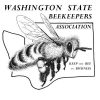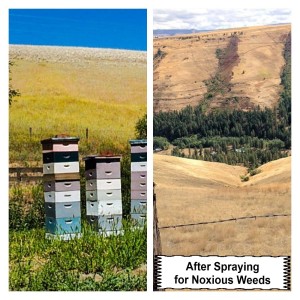
Washington State Beekeepers Association
Keeping the Bee in Business
Forage
Bee health is dependent on good nutrition, which requires plentiful and diverse bounty of plants for foraging. Scientists widely agree that four main issues affect honey bee health: forage/nutrition, parasites/pathogens, pesticides, and genetics.

In a healthy honey bee colony, bees get adequate nutrition and have low parasite, pest and pathogen levels. In Washington State honey bee health suffers due to:
Lack of adequate season-long forage for bees
Loss of forage to development and land management practices, and
Forage lost to weed control practices
Menu
In efforts to remedy these impacts to honey bees, the Washington State Beekeeper’s Association and the Statewide Honey Bee Work Group is seeking support for legislation which will:
Increase forage opportunities on public lands by:
- State agencies developing easily understood and accessible guidance for permitting honey bees to forage on lands they manage, on planting and maintaining forage for honey bees on those lands and evaluating their weed control efforts for timing and necessity to minimize impact to plants that bees use for forage.
Formally incorporate honey bee and other pollinator concerns into the State’s noxious weed listing process by:
- Having a pollinator expert on the scientific panel that advises the State Noxious Weed Board.
- Including a weed-removal risk assessment as part of the weed board advisory process.
- Providing training for county weed control boards in conducting risk assessments for noxious weed control, with bee habitat included as a key variable.
Impacts on bees and beekeepers when adequate forage is NOT available: Beekeepers feed their bees artificial pollen substitute and sugar syrup to keep them alive. The use of artificial diets cannot meet the diversity of nutritional needs of the colony. Sole reliance on sugar syrup can leave the bees highly susceptible to environmental toxins. Most beekeepers provide this supplemental feeding at some point during the year, but it is a stop-gap measure. It not only is less nutritious for the bees, it also is an added cost for the beekeeper. A recent survey puts the average cost per colony for supplemental feeding at $40 per colony per year. For a small-scale beekeeper with 100 colonies, that’s $4,000 annually. For a commercial beekeeper with 10,000 colonies, it would be $400,000 per year.
Why isn’t there enough forage? Noxious Weed Control reduces forage for bees: Many of the plants honey bees forage on in open areas are weeds, some of which are noxious weeds. Of the 142 plants listed as noxious weeds in Washington, at least 27 can provide valuable forage for honey bees. While there may be valid reasons for the listings, problems arise with weed control actions when the needs of honey bees and other pollinators are overlooked or outweighed. Even if the forage plant is a noxious weed, forage removed without being replaced with plants offering nutrition for bees equals a lost forage opportunity. The loss expands when weed control methods eradicate all bee forage in an area even though only one plant type is designated for control. Some broad-spectrum herbicides widely used in noxious weed control have residual actions which prevent any beneficial flowering plant from growing.
Growth and Development contributes to forage loss for bees: According to the USDA Natural Resources Conservation Service, in 1982 Washington had nearly 29 million acres of total rural land (cropland, Conservation Reserve Program lands, pasture, range, forest and other rural land). By 2010, nearly 1 million acres had been lost. Continued growth and development can be expected to bring continued loss of bee and pollinator forage.
Land Management Practices contribute to loss of forage: Land doesn’t have to be converted to lose its value as honey bee forage. Changes in land management also can reduce forage availability. For example:
- More alfalfa cut before the flowers bloom. This increases protein content of the hay, but reduces what was previously an important source of nectar for bees;
- Fewer fence rows, hedgerows and ditches with available bee forage. Removing these may make modern farming easier, but also often removes bee forage.
- More farms with vast areas of single-crop plantings (monoculture). Lack of variation in crops limits the nutrition and forage value of an area.
Some land use and land management changes have mixed value. For example, new orchards provide new opportunities and cash flow for beekeepers, but tree fruit crops also provide limited nutrition for honey bees. After tree fruit pollination, bee colonies often have less food stored than before, and depend on surrounding weeds, cover crops and supplemental feeding for sustenance.